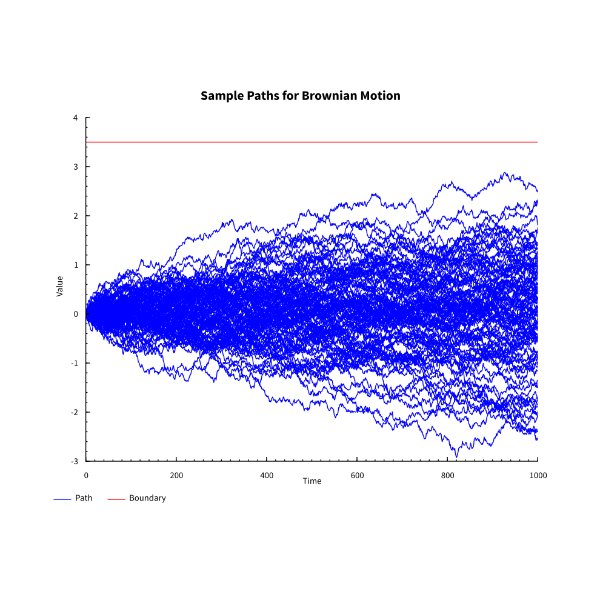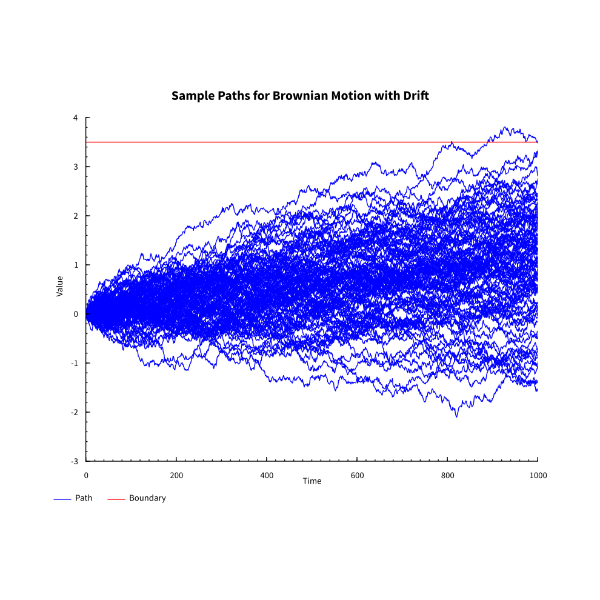Introduction
We previously used importance sampling in the case where we did not have a sampler available for the distribution from which we wished to sample. There is an even more compelling case for using importance sampling.
Suppose we wish to estimate the probability of a rare event. For example, suppose we wish to estimate where
. In this case, we can look up the answer
. But suppose we couldn’t look up the answer. One strategy that might occur to us is to sample and then estimate the probability by counting the number of times out of the total that the sample was bigger than 5. The flaw in this is obvious but let’s try it anyway.
> module Girsanov where
> import qualified Data.Vector as V
> import Data.Random.Source.PureMT
> import Data.Random
> import Control.Monad.State
> import Data.Histogram.Fill
> import Data.Histogram.Generic ( Histogram )
> import Data.Number.Erf
> import Data.List ( transpose )
> samples :: (Foldable f, MonadRandom m) =>
> (Int -> RVar Double -> RVar (f Double)) ->
> Int ->
> m (f Double)
> samples repM n = sample $ repM n $ stdNormal
> biggerThan5 :: Int
> biggerThan5 = length (evalState xs (pureMT 42))
> where
> xs :: MonadRandom m => m [Double]
> xs = liftM (filter (>= 5.0)) $ samples replicateM 100000
As we might have expected, even if we draw 100,000 samples, we estimate this probability quite poorly.
ghci> biggerThan5
0
Using importance sampling we can do a lot better.
Let be a normally distributed random variable with zero mean and unit variance under the Lebesgue measure
. As usual we can then define a new probability measure, the law of
, by
Thus
where we have defined
Thus we can estimate either by sampling from a normal distribution with mean 0 and counting the number of samples that are above 5 or we can sample from a normal distribution with mean 5 and calculating the appropriately weighted mean
Let’s try this out.
> biggerThan5' :: Double
> biggerThan5' = sum (evalState xs (pureMT 42)) / (fromIntegral n)
> where
> xs :: MonadRandom m => m [Double]
> xs = liftM (map g) $
> liftM (filter (>= 5.0)) $
> liftM (map (+5)) $
> samples replicateM n
> g x = exp $ (5^2 / 2) - 5 * x
> n = 100000
And now we get quite a good estimate.
ghci> biggerThan5'
2.85776225450217e-7
Random Paths
The probability of another rare event we might wish to estimate is that of Brownian Motion crossing a boundary. For example, what is the probability of Browian Motion crossing the line ? Let’s try sampling 100 paths (we restrict the number so the chart is still readable).
> epsilons :: (Foldable f, MonadRandom m) =>
> (Int -> RVar Double -> RVar (f Double)) ->
> Double ->
> Int ->
> m (f Double)
> epsilons repM deltaT n = sample $ repM n $ rvar (Normal 0.0 (sqrt deltaT))
> bM0to1 :: Foldable f =>
> ((Double -> Double -> Double) -> Double -> f Double -> f Double)
> -> (Int -> RVar Double -> RVar (f Double))
> -> Int
> -> Int
> -> f Double
> bM0to1 scan repM seed n =
> scan (+) 0.0 $
> evalState (epsilons repM (recip $ fromIntegral n) n) (pureMT (fromIntegral seed))
We can see by eye in the chart below that again we do quite poorly.

We know that where
.
> p :: Double -> Double -> Double
> p a t = 2 * (1 - normcdf (a / sqrt t))
ghci> p 1.0 1.0
0.31731050786291415
ghci> p 2.0 1.0
4.550026389635842e-2
ghci> p 3.0 1.0
2.699796063260207e-3
But what if we didn’t know this formula? Define
where is the measure which makes
Brownian Motion.
We can estimate the expectation of
where is 1 if Brownian Motion hits the barrier and 0 otherwise and M is the total number of simulations. We know from visual inspection that this gives poor results but let us try some calculations anyway.
> n = 500
> m = 10000
> supAbove :: Double -> Double
> supAbove a = fromIntegral count / fromIntegral n
> where
> count = length $
> filter (>= a) $
> map (\seed -> maximum $ bM0to1 scanl replicateM seed m) [0..n - 1]
> bM0to1WithDrift seed mu n =
> zipWith (\m x -> x + mu * m * deltaT) [0..] $
> bM0to1 scanl replicateM seed n
> where
> deltaT = recip $ fromIntegral n
ghci> supAbove 1.0
0.326
ghci> supAbove 2.0
7.0e-2
ghci> supAbove 3.0
0.0
As expected for a rare event we get an estimate of 0.
Fortunately we can use importance sampling for paths. If we take where
is a constant in Girsanov’s Theorem below then we know that
is
-Brownian Motion.
We observe that
So we can also estimate the expectation of under
as
where is now 1 if Brownian Motion with the specified drift hits the barrier and 0 otherwise, and
is Brownian Motion sampled at
.
We can see from the chart below that this is going to be better at hitting the required barrier.

Let’s do some calculations.
> supAbove' a = (sum $ zipWith (*) ns ws) / fromIntegral n
> where
> deltaT = recip $ fromIntegral m
>
> uss = map (\seed -> bM0to1 scanl replicateM seed m) [0..n - 1]
> ys = map last uss
> ws = map (\x -> exp (-a * x - 0.5 * a^2)) ys
>
> vss = map (zipWith (\m x -> x + a * m * deltaT) [0..]) uss
> sups = map maximum vss
> ns = map fromIntegral $ map fromEnum $ map (>=a) sups
ghci> supAbove' 1.0
0.31592655955519156
ghci> supAbove' 2.0
4.999395029856741e-2
ghci> supAbove' 3.0
2.3859203473651654e-3
The reader is invited to try the above estimates with 1,000 samples per path to see that even with this respectable number, the calculation goes awry.
In General
If we have a probability space and a non-negative random variable
with
then we can define a new probability measure
on the same
-algebra by
For any two probability measures when such a exists, it is called the Radon-Nikodym derivative of
with respect to
and denoted
Given that we managed to shift a Normal Distribution with non-zero mean in one measure to a Normal Distribution with another mean in another measure by producing the Radon-Nikodym derivative, might it be possible to shift, Brownian Motion with a drift under a one probability measure to be pure Brownian Motion under another probability measure by producing the Radon-Nikodym derivative? The answer is yes as Girsanov’s theorem below shows.
Girsanov’s Theorem
Let be Brownian Motion on a probability space
and let
be a filtration for this Brownian Motion and let
be an adapted process such that the Novikov Sufficiency Condition holds
then there exists a probability measure such that
-
is equivalent to
, that is,
.
-
.
-
is Brownian Motion on the probabiity space
also with the filtration
.
In order to prove Girsanov’s Theorem, we need a condition which allows to infer that is a strict martingale. One such useful condition to which we have already alluded is the Novikov Sufficiency Condition.
Proof
Define by
Then, temporarily overloading the notation and writing for expectation under
, and applying the Novikov Sufficiency Condition to
, we have
From whence we see that
And since this characterizes Brownian Motion, we are done.
The Novikov Sufficiency Condition
The Novikov Sufficiency Condition Statement
Let and further let it satisfy the Novikov condition
then the process defined by
is a strict martingale.
Before we prove this, we need two lemmas.
Lemma 1
Let for
be a non-negative local martingale then
is a super-martingale and if further
then
is a strict martingale.
Proof
Let be a localizing sequence for
then for
and using Fatou’s lemma and the fact that the stopped process is a strict martingale
Thus is a super-martingale and therefore
By assumption we have thus
is a strict martingale.
Lemma 2
Let be a non-negative local martingale. If
is a localizing sequence such that
for some
then
is a strict martingale.
Proof
By the super-martingale property and thus by dominated convergence we have that
We also have that
By Chebyshev’s inequality (see note (2) below), we have
Taking limits first over and then over
we see that
For and
we have
. Thus
Again taking limits over and then over
we have
These two conclusions imply
We can therefore conclude (since is a martingale)
Thus by the preceeding lemma is a strict as well as a local martingale.
The Novikov Sufficiency Condition Proof
Step 1
First we note that is a local martingale for
. Let us show that it is a strict martingale. We can do this if for any localizing sequence
we can show
using the preceeding lemma where .
We note that
Now apply Hölder’s inequality with conjugates and
where
is chosen to ensure that the conjugates are both strictly greater than 1 (otherwise we cannot apply the inequality).
Now let us choose
then
In order to apply Hölder’s inequality we need to check that and that
but this amounts to checking that
and that
. We also need to check that
but this amounts to checking that
for
and this is easily checked to be true.
Re-writing the above inequality with this value of we have
By the first lemma, since is a non-negative local martingale, it is also a supermartingale. Furthermore
. Thus
and therefore
Step 2
Recall we have
Taking logs gives
or in diferential form
We can also apply Itô’s rule to
where denotes the quadratic variation of a stochastic process.
Comparing terms gives the stochastic differential equation
In integral form this can also be written as
Thus is a local martingale (it is defined by a stochastic differential equation) and by the first lemma it is a supermaringale. Hence
.
Next we note that
to which we can apply Hölder’s inequality with conjugates to obtain
Applying the supermartingale inequality then gives
Step 3
Now we can apply the result in Step 2 to the result in Step 1.
We can replace by
for any stopping time
. Thus for a localizing sequence we have
From which we can conclude
Now we can apply the second lemma to conclude that is a strict martingale.
Final Step
We have already calculated that
Now apply Hölder’s inequality with conjugates and
.
And then we can apply Jensen’s inequality to the last term on the right hand side with the convex function .
Using the inequality we established in Step 2 and the Novikov condition then gives
If we now let we see that we must have
. We already now that
by the first lemma and so we have finally proved that
is a martingale.
Notes
-
We have already used importance sampling and also touched on changes of measure.
-
Chebyshev’s inequality is usually stated for the second moment but the proof is easily adapted:
- We follow Handel (2007); a similar approach is given in Steele (2001).
Bibliography
Handel, Ramon von. 2007. “Stochastic Calculus, Filtering, and Stochastic Control (Lecture Notes).”
Steele, J.M. 2001. Stochastic Calculus and Financial Applications. Applications of Mathematics. Springer New York. https://books.google.co.uk/books?id=fsgkBAAAQBAJ.